Wi-Fi Offload On The Rise: Study

In a trend that could bode well for the cable industry and its increasingly use of Wi-Fi technology, the amount of mobile data traffic being offloaded to Wi-Fi will continue to rise in the years ahead as more and more video is distributed wirelessly, Cisco Systems revealed in its latest five-year mobile data forecast.
According to Cisco’s Visual Networking Index Global Mobile Data Traffic Forecast, about 33% of global mobile data traffic was offloaded on Wi-Fi in 2013, believing that the figure will rise to 46% by 2018.
To relieve the stress on cellular infrastructures, operators have encouraged Wi-Fi data offload, Cisco said, noting that tablet traffic that might that might have migrated to mobile networks has largely remained on fixed networks.
Many cable operators in the U.S. and abroad are deploying Wi-Fi access points to provide value-added wireless access to broadband customers. In addition to using Wi-Fi as a customer acquisition and retention tool, those deployments are also setting the stage for cable operators to provide cellular backhaul and offload services to mobile carriers. In the U.S., the “CableWiFi” roaming consortium (Comcast, Cablevision Systems, Cox Communications, Time Warner Cable, and Bright House Communications) have collectively deployed more than 20,000 hotspots. Comcast announced last week that its customers have access to more than 1 million hotspots, a figure that includes the MSO’s increasing use of quasi-public XfinityWiFi” signals that are being broadcast from customers' home-side DOCSIS-powered wireless gateways.
Cisco expects overall mobile data traffic worldwide to reach 15.9 exabytes per month (1 exabyte equals to 1 billion gigabytes) by 2018, paving the way for an annual run rate of 190 exabytes. The company also projects that global mobile data traffic from 2013 to 2018 will achieve a compound annual growth rate of 61%, outpacing global fixed traffic growth rate by a factor of three.
Video, which made up 53% of the world’s mobile data traffic last year, will rise to 69% by 2018, Cisco added.
The study also predicts that the number of mobile Internet connections, which include a mix of personal devices and machine-to-machine nodes, will exceed 10 billion by 2018, or 1.4 times the world’s population, which will reach 7.6 billion by then, according to United Nations estimates. Mobile users, meanwhile, are expected to rise from 4.1 billion last year to 4.9 billion in 2018.
Multichannel Newsletter
The smarter way to stay on top of the multichannel video marketplace. Sign up below.
Also by 2018, Cisco predicts that smartphones will be responsible for 66% of total mobile traffic, versus 62% last year, adding that 4G/LTE connections will represent 15% of total mobile connections in 2018 and will account for 51% of mobile data traffic. The average mobile network connection speed, meanwhile, is expected to jump from 1.4 Mbps in 2013 to about 2.5 Mbps in 2018, Cisco said.










